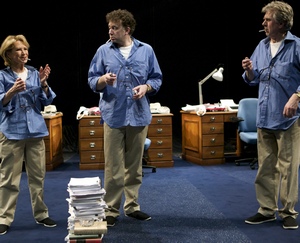SITE GUIDE
SEARCH
REVIEWS
REVIEW ARCHIVES
ADVERTISING AT CURTAINUP
FEATURES
NEWS
Etcetera and
Short Term Listings
LISTINGS
Broadway
Off-Broadway
NYC Restaurants
BOOKS and CDs
OTHER PLACES
Berkshires
London
California
New Jersey
DC
Philadelphia
Elsewhere
QUOTES
TKTS
PLAYWRIGHTS' ALBUMS
LETTERS TO EDITOR
FILM
LINKS
MISCELLANEOUS
Free Updates
Masthead
Writing for Us
A CurtainUp  London Review
London Review
 London Review
London ReviewThe Last Cigarette
| We laughed and laughed until we coughed and coughed.— Simon Gray
|

Felicity Kendal, Jasper Britton and Nicholas Le Prevost all as Simon Gray. (Photo: Manuel Harlan) |
Hugh Whitemore collaborated with Gray while he was still alive and it was Whitemore who suggested three voices for Simon, one of them a woman. So it is that Jasper Britton, Nicholas Le Prevost and Felicity Kendal all play Simon Gray as well as his family and the characters he comes up against, his wife Victoria, his friends and members of the medical profession. The last cigarette of the title is not the last cigarette that one smokes when giving up smoking, but the inevitability that with death will come what will have been the last cigarette, like the one offered to the man under sentence of death.
Richard Eyre, former artistic Director of the National Theatre, directs the three actors dressed identically and seated at identical desks and all three miming lighting cigarettes and smoking, a decision the audience is thankful for after the incessant smoking of just one actor in La Bute's Wrecks. Gray's delightful and touching observations are there: the decision not to answer the door bell leading to endless speculation as to who it might have been. The play opens with the discovery that Gray has cancer and the actors all light up, the lighting turning red and strains of the Bossa Nova as Gray recalls that he was suckled on nicotine milk from his mother. We are told of his father's affair with Little Miss Rolls and treated to revelations about the sex life of his parents through the eyes of a child. There is a whirlwind biography of Gray and his brother as he looks back on his life like the images that are meant to flicker through your mind as you are dying.
The first act has the strange sensation of being a monologue delivered by three people, curiously distracting as we try to work out Gray's character and personality from each of the three identities. The backdrop is often a projected photograph of Gray with a lit cigarette and smoke curling upwards. In the second act it all comes together with a homage to the cigarette, both stylish and funnier. There are detailed descriptions of the patients waiting at the cancer clinic of Dr Rootle, the gloomy "Chipmunk of Doom" oncologist and the smooth charmer, Welsh consultant, Mr Morgan Morgan who blurts out the terrible news that Gray has only a year to live. Here we see Gray's writer's imagination as he pictures the lines of corpses that have gone before at this clinic. There are also some precious moments on holiday in Crete with his wifem with the sun and sea and Greek landscape, or the description of dinner with the Pinters (Harold Pinter similarly determined not to let throat cancer conquer him).
Effective as this dramatic piece is, I must read Simon Gray's autobiographies, all three packaged together in a box which is a large version of a flip top cigarette packet, because the true test of a writer is on the page, an intimacy between writer and reader and imagination. I have read some of Gray's books and greatly enjoyed them and that is his legacy to us all— some excellent plays and writing that brims over with wit, honesty and perception.
| The Last Cigarette
Written by Simon Gray and Hugh Whitemore Adapted from Simon Gray's The Smoking Diaries Directed by Richard Eyre Starring: Jasper Britton, Nicholas Le Prevost and Felicity Kendal Design: Rob Howell Lighting: Jon Driscoll Sound: Jonathan Suffolk Music: John Fenton Running time: Two hours 10 minutes with an interval Box Office: 01243781312 Website: www.cft.org.uk Booking to 11th April 2009 Reviewed by Lizzie Loveridge based on 17th March performance at the Minerva Theatre, Chichester Festival Theatre, Oaklands Park, Chichester, West Sussex PO19 6AP (Rail: Chichester) |
|
REVIEW FEEDBACK Highlight one of the responses below and click "copy" or"CTRL+C"
Paste the highlighted text into the subject line (CTRL+ V): Feel free to add detailed comments in the body of the email . . . also the names and emails of any friends to whom you'd like us to forward a copy of this review. |
|
London Theatre Tickets Lion King Tickets Billy Elliot Tickets Mighty Boosh Tickets Mamma Mia Tickets We Will Rock You Tickets Theatre Tickets |




